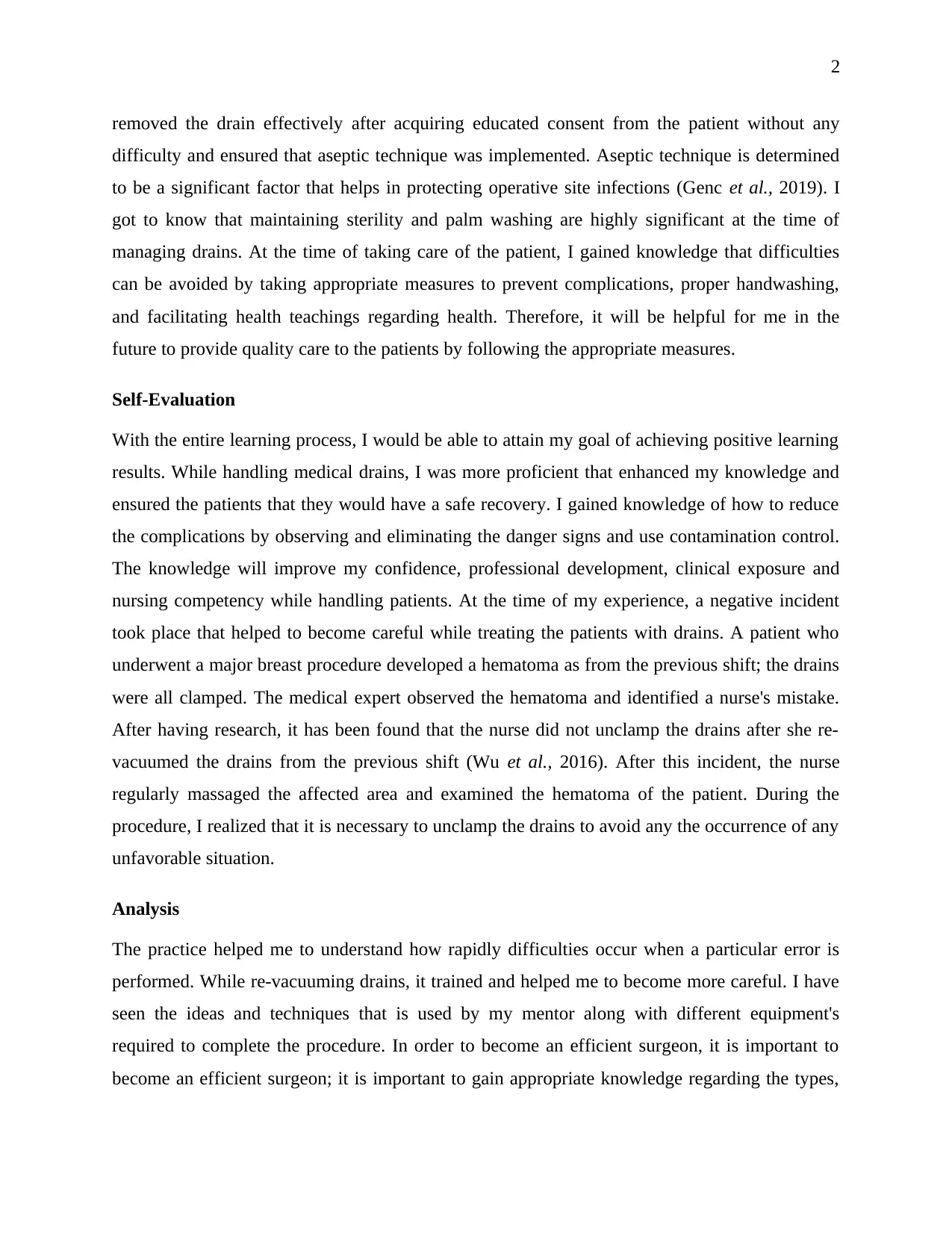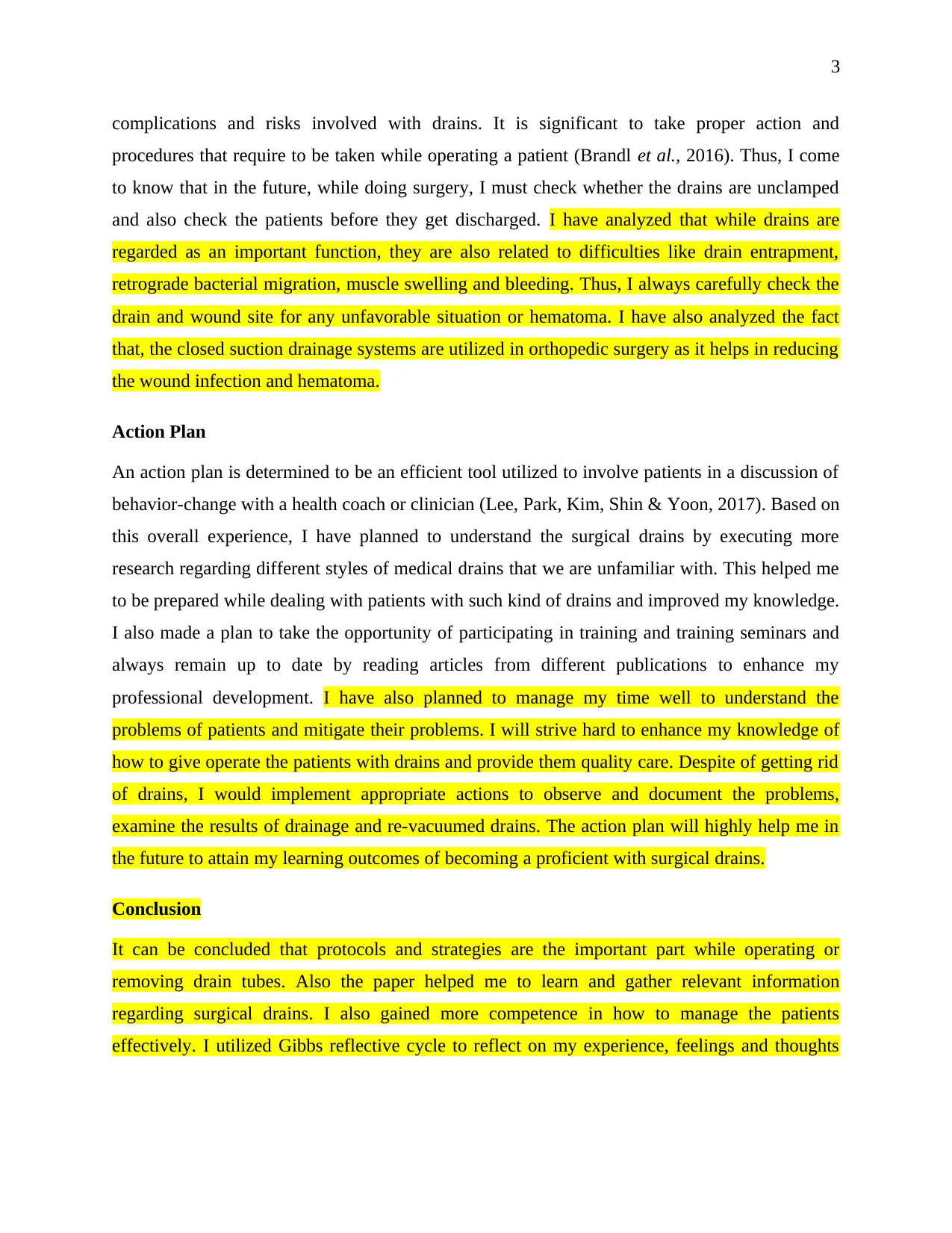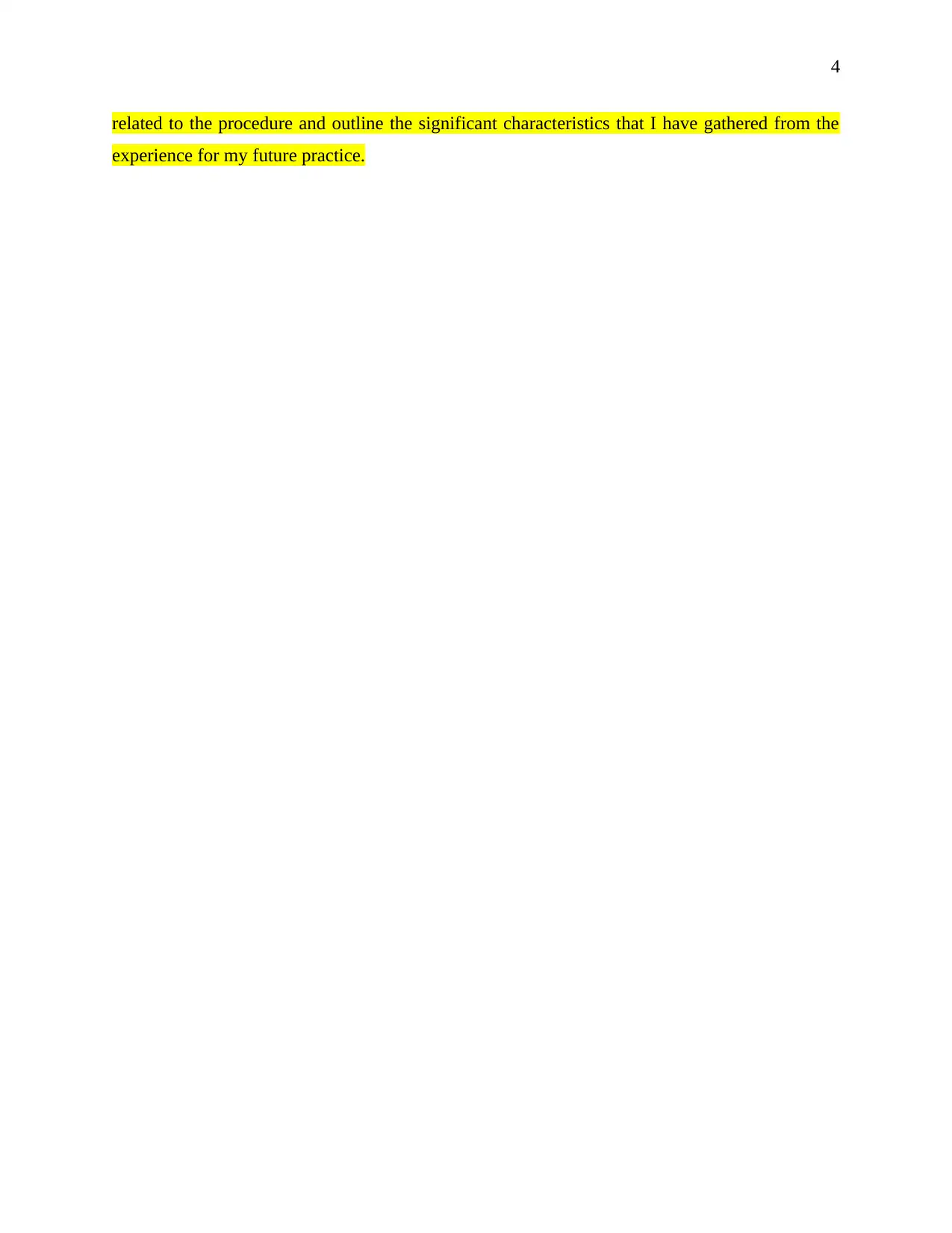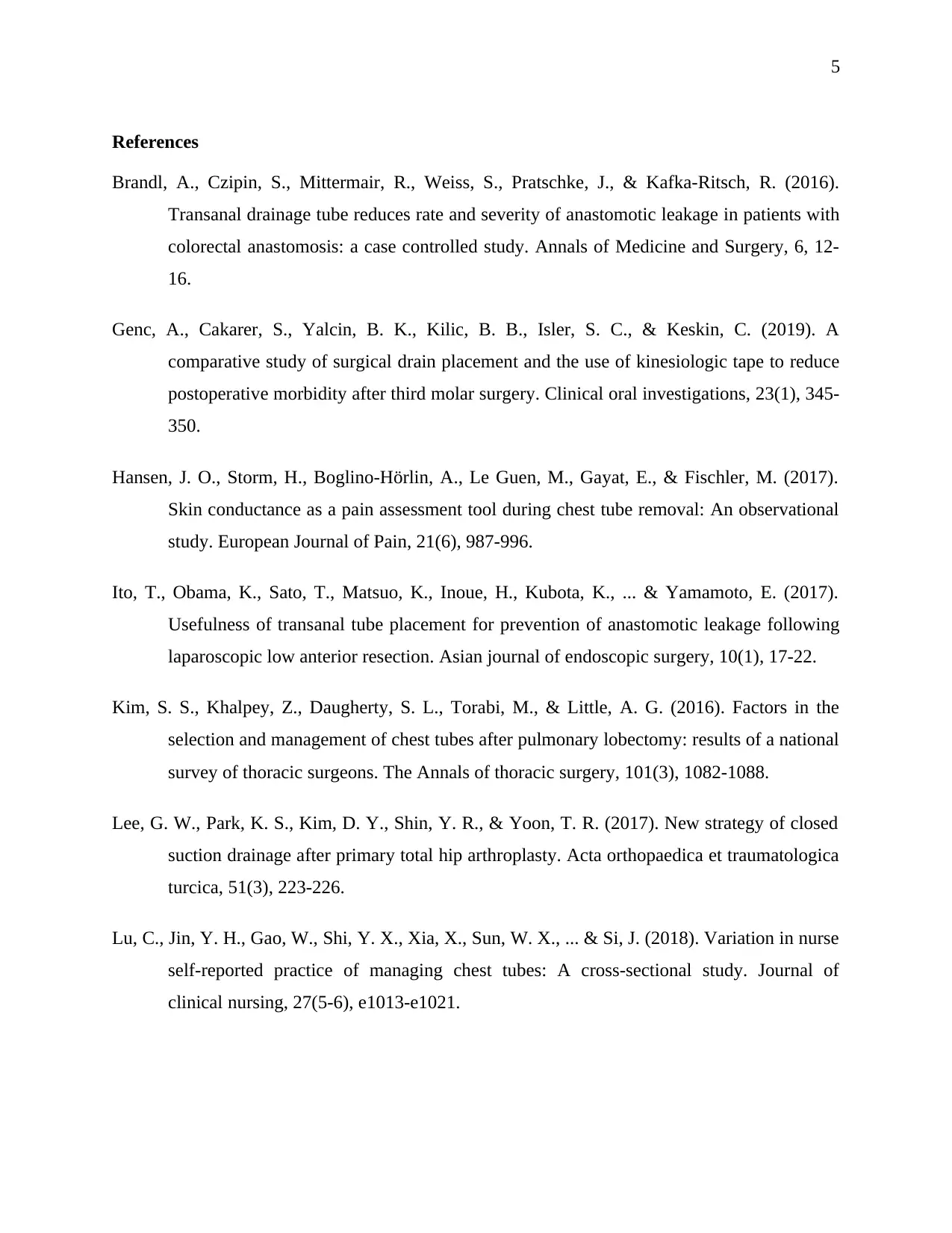Clinical Skills Assessment: Reflective Report on Drain Tube Removal
VerifiedAdded on 2022/09/26
|7
|1794
|30
Report
AI Summary
This report presents a comprehensive reflection on a student's clinical experience involving the removal of surgical drains. The student utilizes the Gibbs reflective cycle to describe the preparation, feelings, self-evaluation, analysis, and action plan related to the procedure. The report details the student's initial nervousness, the guidance received from a mentor, and the successful execution of the drain removal while adhering to aseptic techniques. A significant learning experience involved a critical incident where a clamped drain led to a hematoma, highlighting the importance of meticulous attention to detail. The analysis emphasizes the potential complications associated with drains and the need for vigilant monitoring. The action plan outlines strategies for enhancing knowledge, participating in training, and improving time management to provide quality patient care in the future. The conclusion underscores the significance of protocols and strategies in surgical drain management and highlights the key takeaways from the experience.

Clinical skills Assessment
Student's Name:
Student's ID:
Subject:
Student's Name:
Student's ID:
Subject:
Paraphrase This Document
Need a fresh take? Get an instant paraphrase of this document with our AI Paraphraser

1
Introduction
In a healthcare setting, using drains is determined to be a significant aspect in order to manage
the patients postoperatively (Hansen et al., 2017). It becomes necessary for registered nurses to
serve appropriate care and monitoring of medical drains and implement actions to avoid
problems (Kim, Khalpey, Daugherty, Torabi & Little, 2016). The paper will reflect upon the
procedures and experiences gained while removing drain tubes in clinical settings.
Clinical Practice Preparation (Gibbs Reflective cycle)
Description
In the past, I have been given the responsibility to deal with patients with surgical drains in the
surgical acute care unit. I got to know how to care and monitor for the drains as I have observed
how the cosmetic surgeons remove the drains. In Australia, only surgical resident doctors and
surgeons were allowed to remove drains (Lu et al., 2018). In the surgical ward, I have begun my
adaption program, where I was impressed by how the nurses removed the drain skillfully. This
provided me with an opportunity to become proficient with the care of drains in the future. Thus,
I have gathered information from the senior members regarding hospital strategies and protocols.
I come to know that surgeons always prefer to use the drains of orthopedic patients that are taken
out after 24 hours.
I gained information regarding the tastes of different surgeons in the attention of their patient's
drains. After gathering sufficient knowledge of how to remove drains, I then focused on
enhancing my skills in this particular area. I have noticed my mentor of how she examined, re-
vacuumed and eliminated the drains. All these observations will further help me in the future to
remove the drains of the patients successfully.
Feelings
While I was ready to remove the drains for the very first time, I was a little bit nervous about
whether I would do something wrong. While taking action for the first time, there always occurs
a feeling of nervousness (Ito et al., 2017). When my mentor gave me the confidence to perform
the surgery and guided me throughout the task, I felt a sigh of relief. I was ready with all
personal preventing devices and got the materials ready for doing the surgery. I successfully
Introduction
In a healthcare setting, using drains is determined to be a significant aspect in order to manage
the patients postoperatively (Hansen et al., 2017). It becomes necessary for registered nurses to
serve appropriate care and monitoring of medical drains and implement actions to avoid
problems (Kim, Khalpey, Daugherty, Torabi & Little, 2016). The paper will reflect upon the
procedures and experiences gained while removing drain tubes in clinical settings.
Clinical Practice Preparation (Gibbs Reflective cycle)
Description
In the past, I have been given the responsibility to deal with patients with surgical drains in the
surgical acute care unit. I got to know how to care and monitor for the drains as I have observed
how the cosmetic surgeons remove the drains. In Australia, only surgical resident doctors and
surgeons were allowed to remove drains (Lu et al., 2018). In the surgical ward, I have begun my
adaption program, where I was impressed by how the nurses removed the drain skillfully. This
provided me with an opportunity to become proficient with the care of drains in the future. Thus,
I have gathered information from the senior members regarding hospital strategies and protocols.
I come to know that surgeons always prefer to use the drains of orthopedic patients that are taken
out after 24 hours.
I gained information regarding the tastes of different surgeons in the attention of their patient's
drains. After gathering sufficient knowledge of how to remove drains, I then focused on
enhancing my skills in this particular area. I have noticed my mentor of how she examined, re-
vacuumed and eliminated the drains. All these observations will further help me in the future to
remove the drains of the patients successfully.
Feelings
While I was ready to remove the drains for the very first time, I was a little bit nervous about
whether I would do something wrong. While taking action for the first time, there always occurs
a feeling of nervousness (Ito et al., 2017). When my mentor gave me the confidence to perform
the surgery and guided me throughout the task, I felt a sigh of relief. I was ready with all
personal preventing devices and got the materials ready for doing the surgery. I successfully

2
removed the drain effectively after acquiring educated consent from the patient without any
difficulty and ensured that aseptic technique was implemented. Aseptic technique is determined
to be a significant factor that helps in protecting operative site infections (Genc et al., 2019). I
got to know that maintaining sterility and palm washing are highly significant at the time of
managing drains. At the time of taking care of the patient, I gained knowledge that difficulties
can be avoided by taking appropriate measures to prevent complications, proper handwashing,
and facilitating health teachings regarding health. Therefore, it will be helpful for me in the
future to provide quality care to the patients by following the appropriate measures.
Self-Evaluation
With the entire learning process, I would be able to attain my goal of achieving positive learning
results. While handling medical drains, I was more proficient that enhanced my knowledge and
ensured the patients that they would have a safe recovery. I gained knowledge of how to reduce
the complications by observing and eliminating the danger signs and use contamination control.
The knowledge will improve my confidence, professional development, clinical exposure and
nursing competency while handling patients. At the time of my experience, a negative incident
took place that helped to become careful while treating the patients with drains. A patient who
underwent a major breast procedure developed a hematoma as from the previous shift; the drains
were all clamped. The medical expert observed the hematoma and identified a nurse's mistake.
After having research, it has been found that the nurse did not unclamp the drains after she re-
vacuumed the drains from the previous shift (Wu et al., 2016). After this incident, the nurse
regularly massaged the affected area and examined the hematoma of the patient. During the
procedure, I realized that it is necessary to unclamp the drains to avoid any the occurrence of any
unfavorable situation.
Analysis
The practice helped me to understand how rapidly difficulties occur when a particular error is
performed. While re-vacuuming drains, it trained and helped me to become more careful. I have
seen the ideas and techniques that is used by my mentor along with different equipment's
required to complete the procedure. In order to become an efficient surgeon, it is important to
become an efficient surgeon; it is important to gain appropriate knowledge regarding the types,
removed the drain effectively after acquiring educated consent from the patient without any
difficulty and ensured that aseptic technique was implemented. Aseptic technique is determined
to be a significant factor that helps in protecting operative site infections (Genc et al., 2019). I
got to know that maintaining sterility and palm washing are highly significant at the time of
managing drains. At the time of taking care of the patient, I gained knowledge that difficulties
can be avoided by taking appropriate measures to prevent complications, proper handwashing,
and facilitating health teachings regarding health. Therefore, it will be helpful for me in the
future to provide quality care to the patients by following the appropriate measures.
Self-Evaluation
With the entire learning process, I would be able to attain my goal of achieving positive learning
results. While handling medical drains, I was more proficient that enhanced my knowledge and
ensured the patients that they would have a safe recovery. I gained knowledge of how to reduce
the complications by observing and eliminating the danger signs and use contamination control.
The knowledge will improve my confidence, professional development, clinical exposure and
nursing competency while handling patients. At the time of my experience, a negative incident
took place that helped to become careful while treating the patients with drains. A patient who
underwent a major breast procedure developed a hematoma as from the previous shift; the drains
were all clamped. The medical expert observed the hematoma and identified a nurse's mistake.
After having research, it has been found that the nurse did not unclamp the drains after she re-
vacuumed the drains from the previous shift (Wu et al., 2016). After this incident, the nurse
regularly massaged the affected area and examined the hematoma of the patient. During the
procedure, I realized that it is necessary to unclamp the drains to avoid any the occurrence of any
unfavorable situation.
Analysis
The practice helped me to understand how rapidly difficulties occur when a particular error is
performed. While re-vacuuming drains, it trained and helped me to become more careful. I have
seen the ideas and techniques that is used by my mentor along with different equipment's
required to complete the procedure. In order to become an efficient surgeon, it is important to
become an efficient surgeon; it is important to gain appropriate knowledge regarding the types,
⊘ This is a preview!⊘
Do you want full access?
Subscribe today to unlock all pages.

Trusted by 1+ million students worldwide

3
complications and risks involved with drains. It is significant to take proper action and
procedures that require to be taken while operating a patient (Brandl et al., 2016). Thus, I come
to know that in the future, while doing surgery, I must check whether the drains are unclamped
and also check the patients before they get discharged. I have analyzed that while drains are
regarded as an important function, they are also related to difficulties like drain entrapment,
retrograde bacterial migration, muscle swelling and bleeding. Thus, I always carefully check the
drain and wound site for any unfavorable situation or hematoma. I have also analyzed the fact
that, the closed suction drainage systems are utilized in orthopedic surgery as it helps in reducing
the wound infection and hematoma.
Action Plan
An action plan is determined to be an efficient tool utilized to involve patients in a discussion of
behavior-change with a health coach or clinician (Lee, Park, Kim, Shin & Yoon, 2017). Based on
this overall experience, I have planned to understand the surgical drains by executing more
research regarding different styles of medical drains that we are unfamiliar with. This helped me
to be prepared while dealing with patients with such kind of drains and improved my knowledge.
I also made a plan to take the opportunity of participating in training and training seminars and
always remain up to date by reading articles from different publications to enhance my
professional development. I have also planned to manage my time well to understand the
problems of patients and mitigate their problems. I will strive hard to enhance my knowledge of
how to give operate the patients with drains and provide them quality care. Despite of getting rid
of drains, I would implement appropriate actions to observe and document the problems,
examine the results of drainage and re-vacuumed drains. The action plan will highly help me in
the future to attain my learning outcomes of becoming a proficient with surgical drains.
Conclusion
It can be concluded that protocols and strategies are the important part while operating or
removing drain tubes. Also the paper helped me to learn and gather relevant information
regarding surgical drains. I also gained more competence in how to manage the patients
effectively. I utilized Gibbs reflective cycle to reflect on my experience, feelings and thoughts
complications and risks involved with drains. It is significant to take proper action and
procedures that require to be taken while operating a patient (Brandl et al., 2016). Thus, I come
to know that in the future, while doing surgery, I must check whether the drains are unclamped
and also check the patients before they get discharged. I have analyzed that while drains are
regarded as an important function, they are also related to difficulties like drain entrapment,
retrograde bacterial migration, muscle swelling and bleeding. Thus, I always carefully check the
drain and wound site for any unfavorable situation or hematoma. I have also analyzed the fact
that, the closed suction drainage systems are utilized in orthopedic surgery as it helps in reducing
the wound infection and hematoma.
Action Plan
An action plan is determined to be an efficient tool utilized to involve patients in a discussion of
behavior-change with a health coach or clinician (Lee, Park, Kim, Shin & Yoon, 2017). Based on
this overall experience, I have planned to understand the surgical drains by executing more
research regarding different styles of medical drains that we are unfamiliar with. This helped me
to be prepared while dealing with patients with such kind of drains and improved my knowledge.
I also made a plan to take the opportunity of participating in training and training seminars and
always remain up to date by reading articles from different publications to enhance my
professional development. I have also planned to manage my time well to understand the
problems of patients and mitigate their problems. I will strive hard to enhance my knowledge of
how to give operate the patients with drains and provide them quality care. Despite of getting rid
of drains, I would implement appropriate actions to observe and document the problems,
examine the results of drainage and re-vacuumed drains. The action plan will highly help me in
the future to attain my learning outcomes of becoming a proficient with surgical drains.
Conclusion
It can be concluded that protocols and strategies are the important part while operating or
removing drain tubes. Also the paper helped me to learn and gather relevant information
regarding surgical drains. I also gained more competence in how to manage the patients
effectively. I utilized Gibbs reflective cycle to reflect on my experience, feelings and thoughts
Paraphrase This Document
Need a fresh take? Get an instant paraphrase of this document with our AI Paraphraser

4
related to the procedure and outline the significant characteristics that I have gathered from the
experience for my future practice.
related to the procedure and outline the significant characteristics that I have gathered from the
experience for my future practice.

5
References
Brandl, A., Czipin, S., Mittermair, R., Weiss, S., Pratschke, J., & Kafka-Ritsch, R. (2016).
Transanal drainage tube reduces rate and severity of anastomotic leakage in patients with
colorectal anastomosis: a case controlled study. Annals of Medicine and Surgery, 6, 12-
16.
Genc, A., Cakarer, S., Yalcin, B. K., Kilic, B. B., Isler, S. C., & Keskin, C. (2019). A
comparative study of surgical drain placement and the use of kinesiologic tape to reduce
postoperative morbidity after third molar surgery. Clinical oral investigations, 23(1), 345-
350.
Hansen, J. O., Storm, H., Boglino‐Hörlin, A., Le Guen, M., Gayat, E., & Fischler, M. (2017).
Skin conductance as a pain assessment tool during chest tube removal: An observational
study. European Journal of Pain, 21(6), 987-996.
Ito, T., Obama, K., Sato, T., Matsuo, K., Inoue, H., Kubota, K., ... & Yamamoto, E. (2017).
Usefulness of transanal tube placement for prevention of anastomotic leakage following
laparoscopic low anterior resection. Asian journal of endoscopic surgery, 10(1), 17-22.
Kim, S. S., Khalpey, Z., Daugherty, S. L., Torabi, M., & Little, A. G. (2016). Factors in the
selection and management of chest tubes after pulmonary lobectomy: results of a national
survey of thoracic surgeons. The Annals of thoracic surgery, 101(3), 1082-1088.
Lee, G. W., Park, K. S., Kim, D. Y., Shin, Y. R., & Yoon, T. R. (2017). New strategy of closed
suction drainage after primary total hip arthroplasty. Acta orthopaedica et traumatologica
turcica, 51(3), 223-226.
Lu, C., Jin, Y. H., Gao, W., Shi, Y. X., Xia, X., Sun, W. X., ... & Si, J. (2018). Variation in nurse
self‐reported practice of managing chest tubes: A cross‐sectional study. Journal of
clinical nursing, 27(5-6), e1013-e1021.
References
Brandl, A., Czipin, S., Mittermair, R., Weiss, S., Pratschke, J., & Kafka-Ritsch, R. (2016).
Transanal drainage tube reduces rate and severity of anastomotic leakage in patients with
colorectal anastomosis: a case controlled study. Annals of Medicine and Surgery, 6, 12-
16.
Genc, A., Cakarer, S., Yalcin, B. K., Kilic, B. B., Isler, S. C., & Keskin, C. (2019). A
comparative study of surgical drain placement and the use of kinesiologic tape to reduce
postoperative morbidity after third molar surgery. Clinical oral investigations, 23(1), 345-
350.
Hansen, J. O., Storm, H., Boglino‐Hörlin, A., Le Guen, M., Gayat, E., & Fischler, M. (2017).
Skin conductance as a pain assessment tool during chest tube removal: An observational
study. European Journal of Pain, 21(6), 987-996.
Ito, T., Obama, K., Sato, T., Matsuo, K., Inoue, H., Kubota, K., ... & Yamamoto, E. (2017).
Usefulness of transanal tube placement for prevention of anastomotic leakage following
laparoscopic low anterior resection. Asian journal of endoscopic surgery, 10(1), 17-22.
Kim, S. S., Khalpey, Z., Daugherty, S. L., Torabi, M., & Little, A. G. (2016). Factors in the
selection and management of chest tubes after pulmonary lobectomy: results of a national
survey of thoracic surgeons. The Annals of thoracic surgery, 101(3), 1082-1088.
Lee, G. W., Park, K. S., Kim, D. Y., Shin, Y. R., & Yoon, T. R. (2017). New strategy of closed
suction drainage after primary total hip arthroplasty. Acta orthopaedica et traumatologica
turcica, 51(3), 223-226.
Lu, C., Jin, Y. H., Gao, W., Shi, Y. X., Xia, X., Sun, W. X., ... & Si, J. (2018). Variation in nurse
self‐reported practice of managing chest tubes: A cross‐sectional study. Journal of
clinical nursing, 27(5-6), e1013-e1021.
⊘ This is a preview!⊘
Do you want full access?
Subscribe today to unlock all pages.

Trusted by 1+ million students worldwide

6
Wu, X., Yan, C., Meng, Z., Chen, K., Song, S., Yang, Z., & Yu, J. (2016). Investigation of
characteristics of passive heat removal system based on the assembled heat transfer tube.
Nuclear Engineering and Technology, 48(6), 1321-1329.
Wu, X., Yan, C., Meng, Z., Chen, K., Song, S., Yang, Z., & Yu, J. (2016). Investigation of
characteristics of passive heat removal system based on the assembled heat transfer tube.
Nuclear Engineering and Technology, 48(6), 1321-1329.
1 out of 7
Related Documents
Your All-in-One AI-Powered Toolkit for Academic Success.
+13062052269
info@desklib.com
Available 24*7 on WhatsApp / Email
![[object Object]](/_next/static/media/star-bottom.7253800d.svg)
Unlock your academic potential
Copyright © 2020–2025 A2Z Services. All Rights Reserved. Developed and managed by ZUCOL.





